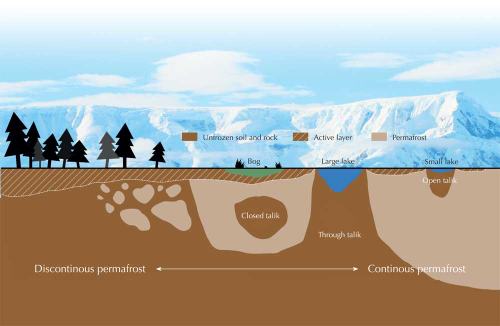Tundra
When I teach my students about the tundra biome, I usually tell them to think of it as a “cold desert.” There are no trees and the precipitation is relatively low (and it is mostly in the form of snow). There are three types of tundra – Arctic, alpine and Antarctic. Which category does Toolik fall under? Post your answer in the Ask The Team section! There’s a clue in the next section that should help you out.
 Geographic distribution of Tundra. Image courtesy of Wikipedia.
Geographic distribution of Tundra. Image courtesy of Wikipedia.
Permafrost and Drunken Trees
The tundra in Northern Alaska is characterized by a layer of soil known as permafrost. Permafrost is a layer of soil that remains permanently frozen for 2 or more years. Plants can grow in what is called the “active layer” (see diagram below).
 Cross-section showing different types of permafrost. Modified image courtesy of PhysicalGeography.net; background image courtesy of Mark Sykes; image source: Flickr
Cross-section showing different types of permafrost. Modified image courtesy of PhysicalGeography.net; background image courtesy of Mark Sykes; image source: Flickr
Every year, permafrost goes through a cycle of freezing and thawing. You can imagine that this endless cycle of cold-warm-cold-warm puts limits on the amount a particular plant can grow – which is why you don’t see huge trees (or any, for that matter) in the tundra, but rather soil hugging shrubs, mosses, lichens and the like. In areas of discontinuous permafrost, like in the sub-arctic taiga biome, this cycle of melting and freezing can create “drunken” trees. The trees roots get disrupted by the layers or ice, and lean over and may eventually fall. Pretty cool, huh?
 “Drunken” trees growing in discontinuous permafrost. Photo courtesy of Wikipedia.
“Drunken” trees growing in discontinuous permafrost. Photo courtesy of Wikipedia.
.
Tundra Vegetation
The tundra can be a cold dark place in the winter, but what about the summer? Abiotic (non-living) factors obviously drive the biotic (living) factors in a major way here. 24 hrs of darkness and snowpack in the winter should kill everything, right? But then why does the tundra seem to spring to life overnight? Many living things are uniquely adapted to remain dormant in the soil (think about that snowpack like a thick warm blanket), so when the day lengthens (and eventually gets to 24 hrs of sunlight at the solstice) and the snow melts, all of those sleeping organisms come alive. Here’s the proof:
 These are just a few flowers I observed on one of our field outings. There are so many more in the tundra!
These are just a few flowers I observed on one of our field outings. There are so many more in the tundra!
Tundra Animals
When people think of tundra, especially in Alaska, most people think the place is roaming with bears, caribou, musk oxen and wolves. While those animals do exist here, they aren’t very common. Since I’ve been here, I’ve seen an arctic fox or two, the arctic ground squirrel, a few loons and a ptarmigan or two. The greatest terrestrial (found on land) life in the tundra exists just where the vegetation exists –the soil. That means that this place is crawling with bacteria, fungi, lichen and insects. Think about it – if flowers and grasses are abundant in the summer, then some living thing needs to be there to help them survive (think pollinators, decomposers, etc), right? If you think about it, most ecosystems store a lot of their biomass (i.e. the collective weight of every living thing in that area) in the soil, so those little critters are pretty special. Stay tuned for future posts to learn more about how these tiny creatures help to keep the tundra ecosystem running.

